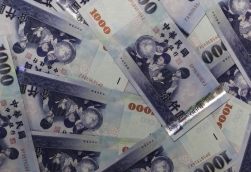Taiwan Dollar Currency Specifics
Over the years, the Taiwan Dollar (NT$) has gained a reputation as one of the most stable currencies in the Asian region thanks to the steady economic management of the country, together with its policies of open investment and trade. The Forex code for the Taiwan Dollar is TWD, and there are around NT$1.8 trillion currently in circulation, with a volume of around US$24 billion being traded each day on the Forex market. The Taiwan Dollar is regulated by the country’s central bank, the Central Bank of the Republic of China (Taiwan), and the country’s monetary policies are implemented by the 15 members of the Central Bank of Taiwan’s board of directors at their monetary policy meetings, which are held quarterly. Currently, the Taiwanese central bank uses a system of monetary targeting to achieve their inflation goals and to promote economic growth. This system allows the bank to set a target range for Taiwan’s M2 aggregate money supply so that an appropriate discount rate can be determined. A number of operational instruments are used to fine-tune the interbank overnight loan rate and reserve money figures, including discounts, required bank reserve deposits, selective credit management, and re-deposits from financial institutions. The TWD is frequently traded in currency pairs with other Asian currencies and other major world currencies such as the US Dollar, the Canadian Dollar, the Australian Dollar, the Euro, the Pound Sterling, the Japanese Yen, the New Zealand Dollar and the Indian Rupee.
| Broker | Bonus | More |
|---|
A Short History of the Taiwan Dollar

Facts About the Taiwanese Economy
Taiwan has a developed capitalist economy which ranks highly in Asia for global entrepreneurship. Many of the country’s largest industrial firms and government-owned banks are now privatised, and the nation’s export industry has grown at a rapid rate since the end of the Second World War. Both unemployment and inflation in the country are low, and Taiwan has a substantial trade surplus. While the agricultural industry was once the mainstay of the Taiwanese economy, today its share of the GDP has fallen dramatically, with the service sector now having risen to prominence over the last 50 years. There has been a strong move towards technology and capital-intensive industries, while more traditional labour-intensive industries are increasingly being moved offshore. The country’s major trading parters include China, the USA, Japan, Hong Kong and the EU, and foreign trade has propelled the rapid growth of the country for the last half-century. The economy of Taiwan is still export-oriented, and the country is thus dependent upon an open-world trading regime, leaving it vulnerable to any downturn in the world economy. Taiwan’s key export sector is the electronics industry, with the nation being the biggest supplier in the world of contract computer-chip manufacturing. Textiles are another major sector for exports, while Taiwan’s imports are primarily capital goods and raw materials as well as energy products.
Which Factors Affect the Taiwanese Dollar?
Although Taiwan has a reputation for having a stable and strong economy, because of the country’s increased dependence on mainland China for its trading the value of its currency is vulnerable to any issues that affect the Chinese economy. The country is also suffering from an ageing population together with a declining birthrate, which has led to some investors speculating about whether or not the country can maintain its role within the Southeast Asian economy. The region is also vulnerable to natural disasters such as earthquakes, which can have a major impact on the health of the nation’s economy and the exchange rate of the Taiwan Dollar.


